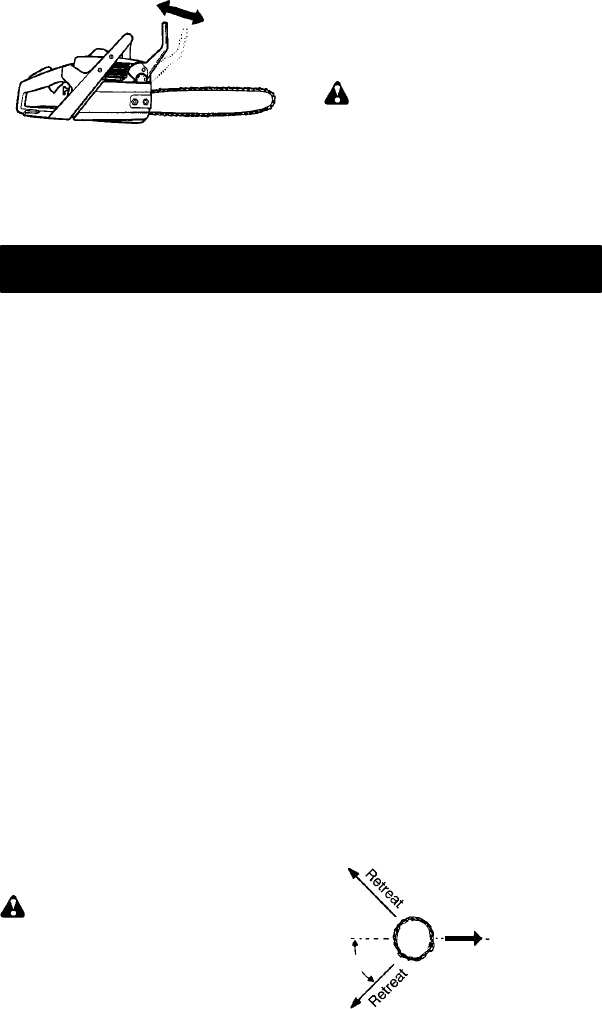
10
S When cutting with the saw,the chain brake
must be disengaged.
Disengaged
Engaged
Braking function control
CAUTION:
The chain brake must be
checked several times daily. The engine
must berunning whenperforming this proce-
dure. This is the only instance when the saw
should be placed on the ground with the en-
gine running.
Place the saw on firm ground. Hold the han-
dles with both hands and apply full throttle.
Activate the chain brake by turning your left
wrist against the hand guard without releas-
ing your grip around the front handle. The
chain should stop immediately .
Inertia activating function control
WARNING: When performing the
following procedure, the engine must be
turned off.
Hold the chain saw approximately 14″ (35
cm) above a stump orother woodensurface.
Release your grip on the front handle and
use the weight of the saw to let the top of the
guide bar fall forward and contact the stump.
When the tip of the bar hits the stump, the
brake should activate.
CUTTING METHODS
IMPORTANT POINTS
S Check chain t ension before f irst use and
after 1 m inute of operation. See CHAIN
TENSION in the ASSEMBLY section.
S Cut wood only . Do not cut metal, plastics,
masonry , non-wood b uildi ng materia ls, etc.
S Stop the saw if the chain strikes a foreign
object. Inspect thesaw andrepair parts as
necessary.
S Keep thechainout ofdirt andsand. Evena
small amount ofdirt will quickly dull achain
and increase the possibility of kickback.
S Practice cutting a few small logs using the
following techniques to get the“feel” of us-
ing your saw before you begin a major
sawing operation.
S Squeeze the throttle trigger and allow
theengine toreach fullspeed beforecut-
ting.
S Begin cutting with the saw frameagainst
the log.
S Keep the engine at full speed the entire
time you are cutting.
S Allow the chain to cut for you. Exert only
light downward pressure.
S Release t he throttle trigger as soon as
the cut is completed,allowing theengine
to idle. If you run the saw at full throttle
without a cutting load, unnecessary
wear can occur to thechain, bar ,and en-
gine. It is recommended that the en-
gine not be operated for longer than
30 seconds at full throttle.
S To avoid losing control when cut is com-
plete, do not put pressure on saw a t end
of cut.
S Stop the engine before setting the saw
down.
TREE FELLING TECHNIQUES
WARNING: Check for broken or
dead branches which can fall while cutting
causing serious injury. Do notcut nearbuild-
ings or electrical wires if you do not know the
direction oftree fall, norcut atnight sinceyou
will not be able to see well, nor during bad
weather such as rain, snow, o r strong winds,
etc. If the tree makes contact with any utility
line, the utility company should be notified
immediately .
S Carefully planyour sawingoperation inad-
vance.
S Clear thework a rea. Youneed aclear area
all aroundthe treeso you can have secure
footing.
S The chain saw operator should keep on
the uphill side of the terrain as the tree is
likely toroll orslidedownhill afterit is felled.
S Study the natural conditions that can
cause the tree to fall in a particular direc-
tion.
Natural conditions that can cause a tree to
fall in a particular direction include:
S The wind direction and speed.
S The lean of the tree. The lean of a tree
might not be apparent due to uneven or
sloping terrain. Use aplumb or level to de-
termine the direction of tree lean.
S Weight and branches on one side.
S Surrounding trees and obstacles.
Look for decay and rot. If the trunk is rotted,
it can snap and fall toward the operator .
Check for broken or dead branches which
can fall on you while cutting.
Make sure there is enough room for the tree
to fall. Maintain a distance of
2-1/2 tree
lengths from the nearest person or other ob-
jects. Engine noise can drown out a warning
call.
Remove dirt, stones, loose bark, nails, sta-
ples, and wire fromthe tree wherecuts are to
be made.
Plan a clear retreat path to the rear and diag-
onal to the line of fall.
Direction of Fall
45_
Plan a clear retreat path


















